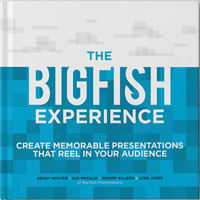Simplifying Content in Your Presentations

You’ve seen it.
We’ve all seen it.
The cluttered presentation, packed tight with small text and bullet points. You’re squinting to read while simultaneously trying to listen to the speaker.
Don’t worry. We’ve all been there.
Whether it’s intended for business, education or entertainment, a presentation can be your worst nightmare when poorly executed.
If you’re a presenter, you feel heavily burdened.
As an audience member, you feel…well, bored.
Overcrowded and confusing information are the major factors in the disconnect that occurs between the message and the audience. Slide design could be stellar and the speaker could be confident and passionate, but if an audience member can’t easily digest the information, then any other skills are deemed obsolete.
So, what’s the solution?
Simplify.
That’s right. Simplify everything.
A good presentation doesn’t use jargon or formal speech. The presentations that really stand out are the ones that are broken down to a basic level and handed to the audience on a silver platter. Don’t make your audience decode the message. They should receive it through osmosis.
Simplifying content is essentially editing on steroids. Anything and everything that could possibly slow down the thought process of an audience member must be thrown away immediately.
Here are a few tips you can use to simplify the content in your next presentation:
- Avoid fluff
“As to the adjective: when in doubt, strike it out.” – Mark Twain
Overly descriptive words take away from the true meaning of something. Instead of describing something in excess, go straight to the point. For example, instead of saying, “The elderly woman was lavishly adorned in floral décor,” say “The old lady wore flowery clothes.”
- Use valuable words
“The most valuable of all talents is that of never using two words when one will do.” – Thomas Jefferson
Space is very valuable in a presentation. If you are using “two words when one will do,” you are using unnecessary space. The more space used, the more your audience is forced to retain. They will be less likely to remember the content. Use your space wisely. For example, “Cop” is shorter than “police officer.”
- Add slides, not bullet points
“Keep it simple, stupid.” – Kelly Johnson
In your presentation, less is more. Keep each slide limited to as few points as possible. The simple solution is to do away with bullet points and emphasize a single point on each slide. For example, the human body prefers to digest food more often and in smaller increments. In the same way, your audience will appreciate and retain content if it is broken up. A longer slideshow means more time, but is loads more effective.
Simplifying content might seem daunting at first, but the payoff is immense. A short and sweet message will allow you to win over your audience and make better use of your time and information. If you want to truly make an impact on your audience, use these tips and adjust your game before your next presentation.
So, here are a few questions to ask yourself before your next presentation.
- How simple is my content?
- Can it be simplified even more?
- If so, where and by how much?
Going through these types of questions while also applying the previously mentioned tips will make you a more effective resource and a killer presenter.




Share your opinion.